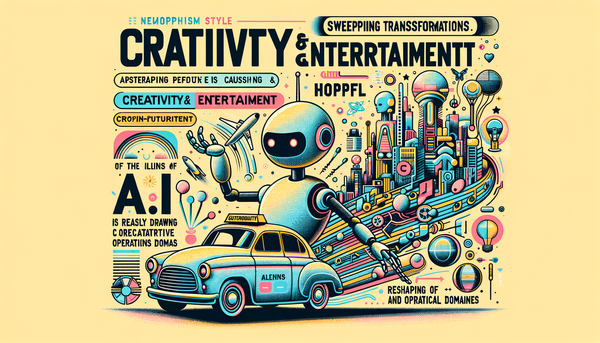Is SoundHound AI a Buy? Exploring AI Investments

Britain’s Competition and Markets Authority recently cleared Microsoft’s OpenAI partnership from scrutiny, a decision that underscores the intricate dance between regulatory oversight and unchecked innovation in the AI ecosystem. This regulatory outcome sets the stage for exploring how industry leaders, shifting market demands, and visionary warns from luminaries all contribute to the evolving narrative of artificial intelligence.
Regulation, Control, and the Microsoft–OpenAI Dynamics
In a landmark review, Britain’s Competition and Markets Authority (CMA) concluded that the longstanding relationship between Microsoft and OpenAI does not amount to a “change of control” under U.K. antitrust laws. Despite Microsoft’s near $14 billion investment in OpenAI and its involvement in reappointing CEO Sam Altman, the CMA found that this partnership has evolved into a more balanced alliance. This decision not only alleviates immediate antitrust concerns but also opens a window to broader discussions on the influence large tech companies can exert on the rapidly evolving AI sector.
It is compelling to note that adjustments in the cloud agreements and a conscious choice by Microsoft to refrain from board-level oversight indicate a strategic move to foster independence within AI development. This evolution highlights a critical shift: instead of consolidating control, the partnership now appears structured to empower OpenAI to harness diverse computing setups, an arrangement that arguably benefits the broader technology community. In many respects, this outcome reassures smaller innovators that there remains room for competition and creativity within the space.
For readers interested in broader technological disruptions, our recent piece on DeepSeek AI’s impact on venture capital further examines how investment strategies are adapting to these nuanced industry trends.
Navigating the Maze: Innovation Versus Regulation
While regulatory bodies work diligently to ensure fairness and competitive balance, a countervailing voice within the tech industry raises concerns over the potential pitfalls of over-regulation. Industry veteran Shubhi Mishra from Raft has warned that excessive regulation might slow down the pace of innovation at a time when adaptability and speed are paramount. Her sentiments echo a broader unease shared by many innovators who fear that stringent rules could stifle creativity and impede breakthrough advancements.
In historical terms, every major technological revolution—from the dawn of the internet to the evolution of smartphones—has been accompanied by a period of regulatory adjustment. However, with AI, the stakes appear even higher. The delicate balance lies in ensuring ethical development and safeguarding against potential misuse without imposing barriers that could inhibit progress. As one expert famously put it:
"A robot may not injure a human being, or, through inaction, allow a human being to come to harm." – Narration from I, Robot
This classic principle illustrates the imperative to protect society while still nurturing an ecosystem where innovation blossoms unhindered. As AI’s applications spread from virtual assistants to complex data analysis, the dialogue surrounding regulation must be as dynamic as the technology itself.
For a closer look at how evolving legal frameworks are impacting creative sectors, consider our article Devon Artists Voice Concerns Over AI Law Changes, where similar themes are explored from a different vantage point.
AI’s Transformative Impact Across Industries
The interplay between regulation and innovation is not confined to technology alone; it spans multiple industries including automotive, insurance, and beyond. For instance, Cerence, a prominent name in the realm of in-car virtual assistants, is experiencing a resurgence in demand for its AI-driven automotive solutions. While some markets have witnessed rocky periods—a moment of “bottoming out,” as one financial analysis described—the robust appetite for intelligent virtual assistants within vehicles reflects a broader trend of digital transformation in mobility.
The automotive sector is rapidly incorporating AI not merely as an add-on but as a fundamental element of new mobility experiences, ranging from voice-activated systems to predictive maintenance. This trend reaffirms the need for industries to continuously adapt in response to innovation, much like how financiers adjust to fluctuating markets.
Equally compelling is the transformation taking place within the insurance industry. Collaborations, such as that between DXC and ServiceNow, are pioneering new ways to integrate AI into everyday operations. These initiatives are aimed at streamlining claims processing, improving customer service, and even enhancing risk assessments. By leveraging AI-powered data analytics, the traditional insurance model is being reimagined with increased efficiency and improved accuracy.
One cannot ignore that such groundbreaking innovations feature prominently in our ongoing coverage of tech investments and strategic business moves. For additional insights into these industry transformations, please explore our feature on AI Stocks & Innovations Update, which provides a detailed analysis of similar market trends.
Investment Perspectives: Navigating the High-Stakes AI Arena
The landscape of AI investment offers a microcosm of the larger industry's dynamic nature. Two separate evaluations from reputable sources—Nasdaq and The Motley Fool—explore the prospects of SoundHound AI, evaluating its potential as a worthwhile buy. Although these analyses vary in perspective, they converge on one point: the rapid evolution and inherent unpredictability of AI-driven markets.
Investors are tasked with weighing the disruptive potential of emerging technologies against the backdrop of a market that can shift dramatically with each innovation. On one hand, pioneering companies like SoundHound AI are crafting unique solutions that promise to reshape consumer interactions, notably in voice recognition and natural language processing realms. On the other, a mix of cautious optimism and risk remains prevalent as market sentiments evolve.
Investing in AI is akin to navigating uncharted waters; market trends can pivot on a dime, propelled by technological breakthroughs or regulatory interventions. Thus, the decision to invest is far less about certainty and more about strategic foresight. In our piece The Best AI Investment Today: My Top Picks, we delve deeper into the multifaceted dynamics that shape AI investments, offering readers an informed perspective rooted in analytical insights and market trends.
The juxtaposition of cautious analysis and aggressive technological advancement makes the arena a fertile ground for both innovation and risk—reminding us all of the age-old adage, "with great power comes great responsibility."
The Ethical & Existential Dimensions of AI
Amid the rapid advancements, the conversation surrounding AI’s ethical and societal implications remains crucial. Recently, celebrated figures honored with the Turing Award have reiterated warnings about the potential dangers of unchecked AI development. These cautions are not meant to discourage progress but to ensure that safeguards are in place as technology scales new heights.
The concerns voiced by these experts revolve around issues such as bias, privacy, and the unforeseen consequences of autonomous systems. Their vigilance parallels the caution observed in historical technological revolutions, where the promise of innovation was tempered by the potential for misuse.
Drawing on research and reflections from luminaries in the field, it's clear that sustainable advancement in AI requires a careful balancing act. As Satya Nadella once remarked, “AI represents a way to unlock human potential. It allows people to focus on innovation and creativity, while machines take care of repetitive tasks.” This sentiment underlines a hopeful vision: one where human ingenuity is amplified by AI, driving us toward a future of enhanced productivity and creativity.
Nonetheless, the juxtaposition of ambition and caution is inevitable. The ongoing debate about the proper level of oversight reflects an underlying consensus: we must tread carefully, ensuring that the transformative power of AI does not inadvertently sow the seeds of its own disruption.
Charting the Future of AI Integration
Looking ahead, the amalgamation of strategic investments, nuanced regulatory approaches, and targeted industrial applications paves the way for AI’s ubiquitous presence across our daily lives. The recent convergence of corporate maneuvering—exemplified by Microsoft’s recalibrated role with OpenAI—and broader market dynamics offers a real-time case study of how innovation, regulation, and ethical considerations intersect.
A particularly compelling narrative is that of balance. On one side, we see regulated giants ensuring that no single entity wields disproportionate control, thereby safeguarding competition and innovation. On the other, industry voices remind us that overly draconian measures might hold back the very progress we seek to celebrate. This duality characterizes today's AI landscape, where each decision carries weight from economic, ethical, and technological perspectives.
Anecdotes from earlier tech revolutions, such as the early days of the internet boom, provide valuable context. Much like the careful regulation that eventually allowed the internet to flourish, modern AI governance may require initial constraints to pave the way for broader, more sustainable growth. This perspective resonates with the cautious optimism expressed by industry visionaries and research communities alike.
Moreover, real-world applications continue to emerge at a blistering pace. Autonomous vehicles rely on sophisticated virtual assistants for safer journeys, while insurance companies leverage AI to analyze risks and predict trends with greater accuracy. Each sector’s transformation not only underscores the practical benefits of AI but also the importance of aligning technological progress with ethical standards.
In observing this fast-paced evolution, I find it both exhilarating and humbling to witness the dawn of an era where human creativity and machine intelligence merge to forge a future replete with unprecedented potential.
Further Reflections and Readings
As we reflect on these multifaceted developments, it is evident that the realm of artificial intelligence is as complex as it is promising. The interplay between corporate strategy, regulatory oversight, and creative innovation invites a continuous dialogue that will shape our technological future.
For more detailed insights on AI innovations and investment trends, you can also check out our articles on The Best AI Investment Today and AI Stocks & Innovations Update. These pieces offer additional perspectives on how industry giants and emerging startups navigate this ever-changing landscape.
To encapsulate the spirit of our exploration, I am reminded of Kai-Fu Lee’s insightful words: "I believe AI is going to change the world more than anything in the history of mankind. More than electricity." His assertion serves as both an inspiration and a caution—a reminder that while technology empowers us, it also challenges us to remain vigilant and thoughtful about its implications.




